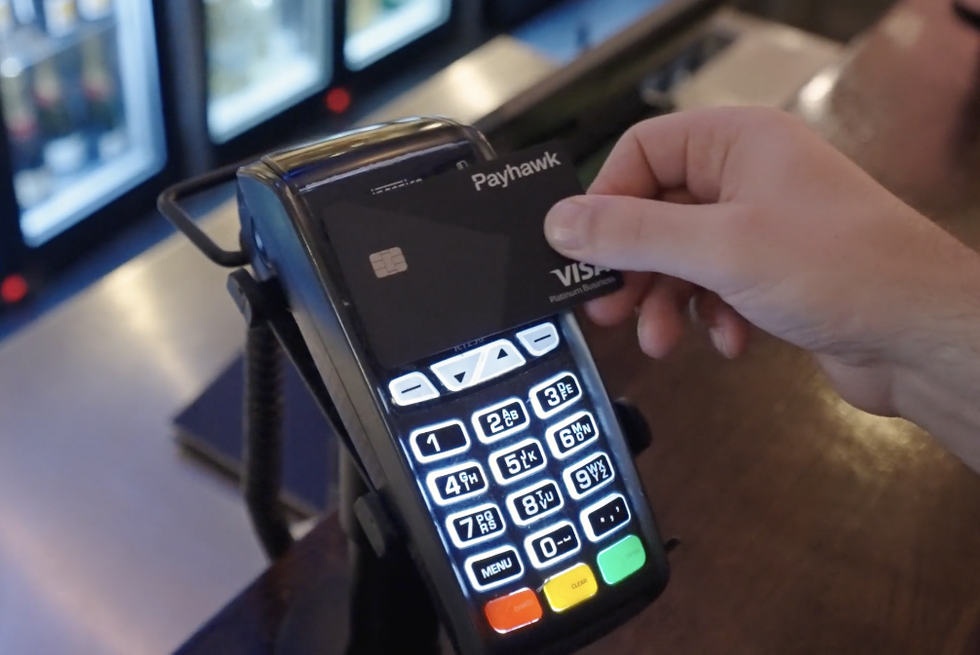
Corporate credit cards: A guide for small business owners



In the past, traditional expense management methods were the go-to for many businesses. However, these methods often included multiple clunky systems that were time-consuming, prone to error and administration-heavy. All this was especially true for small companies, as they lacked the resources to manage expenses in-house.
By submitting this form, you agree to receive emails about our products and services per our Privacy Policy.
Even today, small businesses face a lack of proper processes. They rely on paper receipts and manual data entry, both of which are time-consuming and error-prone.
Additionally, small businesses may not want — or have the infrastructure — for their finance and accounting teams to grow at the same rate as the company, which can be costly and complex.
Some of the biggest issues small businesses face when using traditional expense management tools, include the following.
Lack of visibility
With traditional expense management methods, small business owners often have limited visibility into employee spending. This can make it difficult to pinpoint areas to make savings, manage cash flow effectively, or uncover fraudulent or unauthorised spending.
Uchenna, Finance manager at arts fabrications company MDM Props, explained. “Before switching to Payhawk for our spend management solution? We used two different credit card systems, one from Barclays and one from AMEX. With the Barclays card, you would get a monthly statement, which you had to pay in seven days. But sometimes, when we’d log into the system to retrieve the statement, it wasn’t available. So, we didn’t know what we were paying, which was bad for cash flow. We had to download a pdf statement then physically get the receipts and attach them to the statement, and it would take days or even weeks to reconcile.”
“We also had to wait two to three days for payments to show up,” Uchenna continued. “But, with Payhawk, we can categorise the spend by projects with custom fields too, so it’s super easy to see what’s being spent and why.”
Get complete spend control and visibility with corporate credit cards
Time-consuming processes
Manual processes are often a big part of traditional expense management. These processes can include saving and chasing paper receipts and manually entering data. This can be time-consuming, full of errors, and an unnecessary distraction from important business matters.
Difficulties with tracking spending
Small business owners may struggle to keep track of spending across different categories, such as travel, office supplies, and entertainment. This lack of transparency over spending makes it challenging to stay within budget and identify areas where they can reduce expenses.
Lack of control over spending
With traditional expense management methods, businesses may be unable to set spending limits or control where and how employees use company funds.
Luckily, the shift towards digitalisation has significantly changed how businesses conduct transactions.
Nowadays, there are a few ways to overcome the above challenges, such as smart expense management software, corporate bank cards, and more. However, many of these tools feature their own challenges, as they often run on entirely separate disconnected platforms without the ability to implement robust spend controls.
See what our cards can do
Why should small businesses use corporate cards?
Before we dive deep, it's crucial to make one clarification. Traditional credit cards offered by banks have been here for quite a while. But, traditional credit cards only solve part of the problem, giving access to funds. The real challenges lie in what's happening before and after someone has the funds.
First and foremost, corporate cards are a great way to shine a spotlight on corporate expenses. Finance teams can see every transaction in real time and get complete transparency over every payment. Unlike traditional payment methods, corporate credit cards provide a modern approach to managing expenses.
Corporate card solutions (featuring expense management software) offer businesses a centralised and automated system for tracking expenses, making monitoring and controlling spending easier. Plus, with the integration of accounting software, expense reporting becomes automated, reducing the administrative burden associated with manual tracking.
It also provides valuable insights into spending patterns, enabling businesses to make informed financial decisions and identify cost-saving opportunities.
At Payhawk, our card is a corporate credit card that can help small businesses streamline their expense management processes. It offers a range of features that provide greater visibility and control over spending.
In addition to the benefits of automated expense reporting and spending insights, we also offer additional controls and governance, customisation per need and team, incentives such as cashback, automatic reconciliation, AI-powered data extraction, and more. These features reduce manual work by helping to classify expenses and seamlessly transfer them to ERPs and accounting tools. Overall, corporate credit cards offer small businesses a more efficient and effective way to manage their expenses.
"Before Payhawk, we used a couple of point solutions, excel, and a few different credit cards, but we didn't have an all-in-one centralised solution," CFO at Essentia Analytics, Carolina Einarsson, said.
"For us, improving spend management by moving to Payhawk was a quick win. We saw Payhawk as the future where we could have expense data entry, credit cards, approvals, spend requests, paying invoices, reimbursements — all in one."
Small businesses often need help with processes for handling expenses. Part of that is because as companies grow, the previous processes seem immature and unscalable (and they don't have any teams or tools dedicated to improving them).
At Payhawk, we believe a few pillars set up every organisation for stellar performance. And choosing the right corporate card solution is one of them.
Need help implementing and using a corporate card solution?
Here are our top tips:
Governance and control
At Payhawk, our corporate cards allow you to customise credit card settings for every team and employee. Building, automating, and enforcing business spend policies, including how much employees can spend, daily limits, and more, are the key to achieving an efficient and streamlined finance process.
There will always be teams and employees that need to spend a lot of funds. Providing them with an automatic limit sufficient to their needs is one of the most critical time-saving actions your finance team can take. Depending on the organisation, this will vary from team to team, but marketing is typically one of the usual suspects.
Flexibility over spend and policy doesn't need to mean a lack of control. Some of the most valuable restrictions you can apply on corporate cards include daily and single transaction limits or even white-listed merchants to which they can make transactions. This way, you can ensure employees are empowered to spend while still preventing fraud and unauthorised spending.
"At Rentals United, we've established budgets and implemented card usage with predefined limits to ensure compliance with our spend policy. If someone wants to go outside the budget, they have to submit a request through the app and explain the reason," explained Javier Gorena, CFO at Rentals United. "Then, thanks to personalised approval flows, the designated people can either accept or reject those extraordinary funds (and they get a reminder to do so)."
Another point often overlooked when building the right policy is ensuring employees' autonomy. Usually, projects or initiatives require multiple people to spend from a shared budget. Bringing multiple cards to the same shared limit is an excellent way to empower employees and eliminate the need to micromanage them.
If we're being realistic, we know there will always be exceptions, even if we build the most complex and thorough spend policy together.
In fast-moving small businesses, employees must be able to request and/or approve requests on the go. Giving employees a way to request additional funds, implementing multi-level approval chains depending on the requested amount, and ensuring the finance team has complete visibility over these requests are some of the most important principles of governance and control.
Employee satisfaction and perks
Although it sounds counterintuitive, employees are the main stakeholders when it comes to building a robust expense solution. Out-of-pocket expenses are a 'friction factor' and not the most effective way of handling company expenses.
Introducing corporate credit cards offers benefits beyond the obvious ones, like control and visibility. They frequently come with perks like cashback, which can help your business either reduce expenses or have a net positive impact on spending.
Ultimately, giving cards to employees can help small businesses to save money and manage risk more effectively. This also improves the employees' experience, as they won't have to pay out of pocket and wait for reimbursement.
Month end process optimisation
Month-end madness can be a real challenge for businesses, big and small. It involves juggling financial reports, reconciliations, and performance assessments.
Our number one tip? Choose a corporate credit card solution that comes with automatic bank reconciliation. You should expect your spend management solution to automatically match the card transaction to the proper expense categorisation to help you handle large transactions.
Beyond month-end close, automatic data transfer to your ERP and accounting tools is critical for audit and quarter-end and year-end close. At Payhawk, we deeply understand how customers use their ERPs and accounting tools, making it easy for small businesses to stay on top of their finances, streamline their accounting processes, and ensure that our credit cards integrate seamlessly with their existing tools.
"We have five entities in the Payhawk platform — and, in the parent company, we have 300-500 monthly expenses. With the direct Payhawk integration to NetSuite, I no longer have to review, import and export, and put it in the correct format (which used to take me up to one day for one entity)," Eduardo Felipez, Management Accountant at Heroes said. "With the direct NetSuite integration, I spend about an hour daily on this. It's an enormous help for me."
How Payhawk makes corporate card management easier for business owners: In a nutshell
Managing corporate credit cards doesn’t have to be a headache. We brings all the tools you need together, helping you take control of expenses without the hassle. Here’s how:
Instant spend visibility
With Payhawk, you don’t have to wait until the end of the month to know where your money went and why. See transactions as they happen, get real-time insights, and manage cash flow on the go. It’s like having a live feed of your business’s spending.
Automated expense eeporting
Say goodbye to chasing receipts or waiting for employees to submit reports. At Payhawk, we automatically categorise expenses and lets users upload receipts right from the app, keeping everything organised and easy to find. Less paperwork, more productivity.
Customisable spend controls
You can set spend limits for each card based on the user’s role or project needs, so there’s no room for surprise expenses. Whether it’s a daily limit, a project budget, or specific vendors, we let you keep control without micromanaging.
Flexible approval flows
Need a bit more oversight? Your approval workflows in Payhawk can be customizsd to fit your business structure. Set up multi-level approvals, so every purchase aligns with your policies, and you’re never caught off guard.
Direct ERP integration
With direct integration into accounting software like NetSuite and Xero, our solution will save you from manually transferring data. Transactions sync automatically, making month-end a lot smoother and freeing up your finance team’s time (some of our customers have even saved + 4 days a week!)
Employee perks & cashback
Not only does Payhawk help control spending, but it also brings some perks. Our corporate cards offer cashback, adding extra value to your business. Plus, when employees have their own cards, they don’t have to use personal funds and wait for reimbursement—making life a little easier for them, too.
Built-in security features
Security is a top priority with Payhawk. Set restrictions on each card, like daily spending caps or approved vendors, to help prevent fraud and unauthorised spending, and get peace of mind knowing your funds are protected.
With corporate credit cards from Payhawk, business owners can streamline spending, improve financial control, and give their teams the resources they need — all without the headaches and time-drains.
Your next steps
As the world becomes increasingly digital, the use of corporate credit cards is evolving. Small business owners, in particular, can make the most of their corporate credit cards by establishing clear policies and procedures, monitoring transactions regularly, using expense management software, paying bills on time, and using credit cards for business expenses — even with a small team.
Are you curious to learn more about using corporate cards in your workplace? Book a demo to see our spend management solution in action.
Hristo is the compass guiding Payhawk's journey. With a rich background in engineering аnd product management he is a stalwart advocate for our products and customers, bringing a mix of innovation and user-centricity to everything we do. Outside the office, you'll catch him enjoying camper and sailing trips, shredding slopes on his snowboard, or simply soaking up precious moments with his family.
Related Articles


Top ways to streamline expense management across transport and logistics

